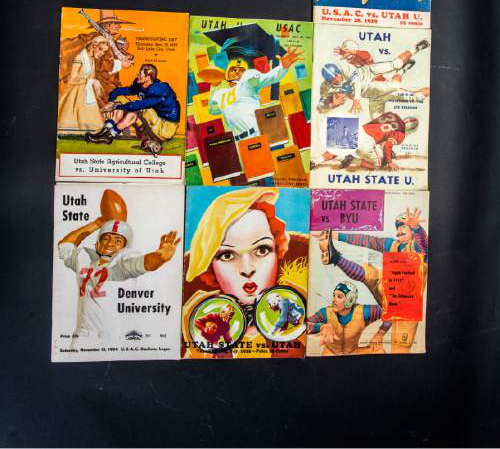This is an archived article that was published on sltrib.com in 2015, and information in the article may be outdated. It is provided only for personal research purposes and may not be reprinted.
Nine-year-old David Mills is an old-school football fan.
Belonging to a family of Utah State season-ticket holders, he loves to save the game programs sold at stadiums, memorizing the Aggie roster and pulling out the publications during the offseason to study the records section.
Such reading habits distinguish him in a digital world that has reduced the demand for any printed product. Fans who paid 25 cents for a Utah vs. Utah State game program on Thanksgiving Day in 1935 would be shocked to discover that most of that information is available on the phones of stadium patrons these days. That's why, in an informal survey, some fans described buying a program as "pointless."
Weber State is enhancing its free, digital offering of game-day stories and information and considering doing away with printed programs, reflecting the changing times. Yet at Utah, program sales and interest from advertisers have remained steady over the past decade or so. And Utah State has increased its printing of programs in recent years, amid rising attendance.
As for the publications themselves, studying the way game programs have evolved provides a glimpse into society. From the mid-20th century, when cover illustrations often would deride the opponent or create caricatures of their own mascots, programs now serve mostly to promote the home school and its athletes. Utah has moved past the era when a drawing of an Indian in a headdress and loincloth, holding a hatchet, was shown in a 1939 publication. Most program covers now are glossy productions that feature photos of senior players.
In many ways, the publications serve the same purpose as ever — previewing the game, providing lineups and rosters and highlighting other aspects of the school.
Most of that information is readily available online, for free. Even so, about 10 percent of ticket-buyers at in-state schools purchase programs. Considering the publications are designed to be shared — unlike a hot dog, for example — that's a significant number. Per-capita printing is higher for the Utes' other big spectator sports, though. Utah produces 5,000 programs for football games, attended by about 46,000 fans at Rice-Eccles Stadium — compared with 3,000 programs for men's basketball and 5,000 for women's gymnastics in the 15,000-seat Huntsman Center.
Even though team rosters can be downloaded, many fans such as BYU booster Brandon Garrett like to buy a program at the home opener and reuse it during the season. As David Mills' example suggests, programs are popular among children. "My kids always want me to buy one," said Alex Stoddard, "but I guess I'm too cheap."
Many fans collect programs, with varying criteria. Utah State supporter Tim Bargsley, a former Aggie staff member, is at one extreme. Bargsley saved programs from every game he has attended in Logan since 1985. Others make sure to buy and keep them from bowl games or other significant events. In 2008, when Utah went 13-0, "If I hadn't been a broke college student, I would have bought a few," said Utah fan Joseph Silverzweig.
Twitter: @tribkurt Program discoveries
Information and observations from a random search of college football game programs in the state's history:
• ZCMI's back-page ad on Thanksgiving Day in 1929, previewing Utah's matchup with Utah State and suggesting, "This season's performance would indicate a victory for the Redskins in today's game, but in a contest with the Aggies one never knows" (Utah won 26-7 to complete a 7-0 season).
• A travel agency offering steamship passage to Hawaii with the Utah football team in 1935 for $150, departing from Los Angeles on Dec. 7 and returning on New Year's Eve.
• Utah State's Aggie Quarterback Club credited with raising $8,200 for scholarships in 1953-54.
• An essay in Utah State's 1954 program advising, "Natural reactions of most fans are to criticize the player who makes a mistake. But do we stop long enough to consider that the player is a human being, just like us?"
• Bratten's Grotto providing a free dinner to Utah's offensive and defensive player of the week in 1960.
• San Jose State lineman Ron McBride, pictured as one of the Spartans' top players in a 1961 matchup vs. BYU.
• An "All in a Player's Day" look at BYU's Gene Frantz, including a shot of him showering, in 1962.
• BYU's offensive line weighing an average of 191 pounds, including right guard Roger DuPaix at 185, in 1962.
• USU's promoting a "WAC Rally Night" in 1962, after the school was left out in the initial formation of the Western Athletic Conference, with a 1,100-pound steer among the door prizes: "Join the rally and back the Aggies. We're tired of being independents."





